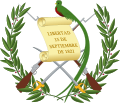| This article is part of a series on |
| Politics of Guatemala |
|---|
 |
Parliamentary elections were held in Guatemala on 14 August 1994, [1] following the premature dissolution of Congress during the 1993 constitutional crisis, and in view of implementing constitutional reforms approved in January 1994. The result was a victory for the Guatemalan Republican Front, which won 33 of the 80 seats. Voter turnout was just 21%. [2]
Contents
The 1993 constitutional crisis started on 25 May 1993, when the then President Jorge Serrano Elías attempted a self-coup or autogolpe. Serrano suspended the constitution, dissolved Congress and the Supreme Court, imposed censorship and tried to restrict civil liberties. [3] Serrano's actions were met with broad national and international opposition and ruled "illegal" by the Constitutional Court, following which Serrano was forced to resign.